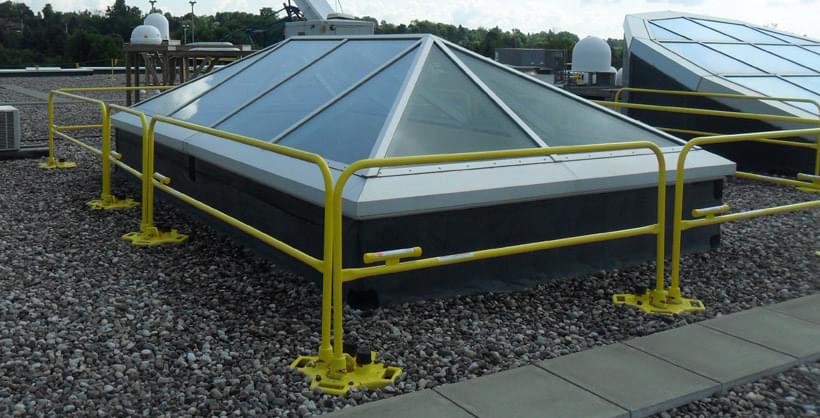If you're a construction worker or safety manager, you know that rooftops are full of accidents waiting to happen. In fact, falls are the most common cause of workplace injury and death in the construction industry. Injuries from falls can have a devastating effect on an employee’s emotions, finances, and health, not to mention on their family. What's more, the costs associated with a fall can take quite a financial toll on a business. For all of these reasons, it is so important to understand the risks involved with construction work, enact proper rooftop safety procedures, and use appropriate roof fall protection.
Whenever construction workers are performing jobs on a rooftop, there are myriad hazards that can cause a serious accident. Identifying the most common rooftop safety hazards is the first step in preventing injuries. Providing safety training and defining safety protocols is imperative. And properly installed rooftop safety systems will ultimately ensure a safe workplace for construction workers.
The dangers of rooftop work actually begin at ground level. During some phases of construction, a building doesn't have interior access to the roof, and workers have to use ladders. If the ladders aren't properly secured to the building, they can be unstable and dangerous to use. A sideways wobble could easily cause someone to lose their balance and fall, especially while on their way up a multi-story building. Beyond making sure the ladder is secured, it's vital that workers use a safety harness when climbing above 6 feet.
In later stages of construction, workers are able to gain roof access via a roof hatch, or other entrance from the interior of the building. These hatches pose a threat for workers who could fall into them, which could cause serious injuries, or even death. A worker carrying tools or materials may need protection from these openings since their vision is obstructed. Preventing falls through hatches requires workers to pay close attention, but it also requires passive safety equipment like special rooftop safety railings for hatches.

While skylights are a great way to bring natural light into a building, installing them and working around them can be problematic. For starters, large openings have to be made in the roof to accommodate them, creating an instant hazard. After they're installed, they're still dangerous as they can't handle the weight of a worker walking across them. A special guardrail designed for skylights will keep people from falling through.
Working on the leading edge of a roof, whether during initial construction or on existing buildings, is one of the riskiest jobs on a site. When there's no barrier on the roof edge or the barrier walls are too short, there is nothing to prevent someone from tumbling over the side. Safety railings are imperative in these instances, and in some cases, it may also be necessary to employ active roof fall protection like a safety harness as well.
Construction materials and tools have to be easily accessible to the workers on the roof when they're needed. The problem is, the more tools and supplies that are on the roof, the less clear space is available, and everything becomes a potential tripping hazard. While you can't remove everything from the roof and bring it up as you go, surrounding storage areas with a dependable portable guardrail minimizes the chances that someone will trip.
The temperature on a roof, especially combined with bright sunlight, is unrelenting and poses a serious threat to workers. When sweat is pouring down your brow and the sun is beating down on you, it's harder to see what’s around you. Feeling overheated and tired is a distraction that is an invitation for an accident to happen. In these situations, drinking plenty of water, wearing protective eyewear, and using passive rooftop safety systems are of the utmost importance.
Moisture on a rooftop creates a slick surface that is nearly impossible to walk on, especially on rooftops that have a steep pitch. But, even flat roofs can be dangerous in wet conditions. Ice buildup can turn a rooftop into a skating rink. While working in those conditions isn't the most desirable, the work sometimes has to proceed regardless of the weather. Installing passive roof fall protection and using active protection are extremely important in this situation.
Regardless of how much safety training construction workers receive, or how strictly you follow protocol, individual responsibility is important as well. Oftentimes, long-time construction workers cite their safety records, even though they don't always use the proper safety equipment. Statistically, an accident will happen on your job site, and lax attention to safety issues can catch up to you. Therefore, it’s important to make sure apathy doesn’t take hold of your crew. Keep them up-to-date on the latest safety standards and best practices, so that safety is always top of mind.
Overlooking safety issues is a serious offense, especially in the eyes of OSHA. Failure to provide adequate rooftop fall protection for workers will result in hefty fines. To avoid fines and other costs and keep the morale of your crew high, make sure you fully assess your safety needs.
Whenever you or your construction crew are working on a rooftop, it's vital that you assess every potential risk and mitigate them before an accident happens. Everyone on the site has to understand the proper procedures for accomplishing the job and avoiding any injuries along the way. Installing passive roof fall protection systems, like safety railings or skylight guardrails, is an essential step in creating a safe environment. In some cases, it may also be necessary to incorporate more active devices such as safety harnesses. Finally, it's important to nurture an overall atmosphere of rooftop safety among workers, so that everyone stays safe every day.